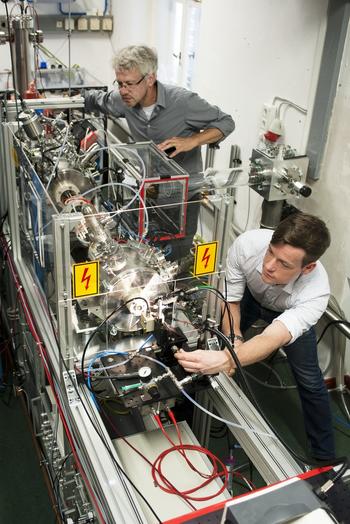An Infrared Spectroscopy Approach to Follow β-Sheet Formation in Peptide Amyloid Assemblies
Following β-Sheet Formation in Peptide Amyloid Assemblies
News from Sep 26, 2016
Molecular Stew Analysis produces World´s first Description of Amyloid Intermediate Structures
Alzheimer´s disease is the most common form of dementia, predominantly in the age group of 65-85 years. There are currently 48 million known patients with Alzheimer´s disease worldwide. This number is expected to double by 2050.
Our newest work, which was done in a collaboration with Dr. Gert von Helden from the Fritz Haber Institute of the Max Planck Society, was published in the current issue of Nature Chemistry and makes a major step forward in analyzing the biochemical causes of Alzheimer´s and Parkinson´s disease. The results could enable the development of new medications fighting the causes of both diseases.
The causes of neurodegenerative diseases like Parkinson´s and Alzheimer´s disease are not fully understood to this day. In both cases, a biochemical disorder can be observed during the course of the disease, but the exact mechanism is unknown. Water-soluble proteins undergo a spontaneous transition into insoluble amyloid fibrils. In the case of Alzheimer´s disease, protein fragments that the body can normally easily dispose accumulate to abnormal species called amyloid plaques, which are deposited outside the neurons and slowly degenerate the brain.
Recent research showed that these plaques are an effect, but not the cause of Alzheimer´s disease. Instead, scientists focus more and more on the issue of what causes the deadly plaque accumulation and why exactly the harmless water-soluble Jekyll proteins turn into the dangerous, insoluble Hyde fibrils. There is increasing evidence that the disease-causing factor is a toxic intermediate that occurs during the aggregation into fibrils, but analyzing the exact structure of these intermediates was an unresolvable problem, resembling the children´s birthday party game of blind man´s bluff. From the perspective of a researcher, the toxic intermediates are not nicely separated species, but present themselves as parts of a stew with unknown ingredients. The research on pharmaceutically active compounds was, therefore, often more or less trial and error up to now. This problem has now been solved by the research performed at the Freie Universität and the Fritz Haber Institute.
For the first time our research groups succeeded in developing a method to exactly analyze and describe the toxic intermediates believed to be triggering the disease on a molecular level. We succeeded in separately analyzing each individual ingredient of the stew and specifically describing their structure. Based on this basic research, other scientists can now start developing specific compounds to neutralize the intermediates causing Alzheimer´s disease.
This was achieved by combining two elaborate methods. Each method alone is incapable of solving a part of the problem, but combined they did the trick. The first method is ion-mobility spectrometry, which can best be described as a molecular wind tunnel, which separates the intermediates according to their drag coefficient. This method, however, only provides information about the size and shape, but not the molecular structure producing the drag. To shed light on this problem we additionally used gas-phase-infrared spectroscopy. Using this combination of methods, the discovered specific intermediates that closely resemble the structure of the mature Hyde fibrils that are present in deadly amyloid plaques. With the newly developed method, other researchers can now test new medications to specifically tackle the emergence of Alzheimer´s disease.
read the full article here (DOI: 10.1038/NCHEM.2615)





